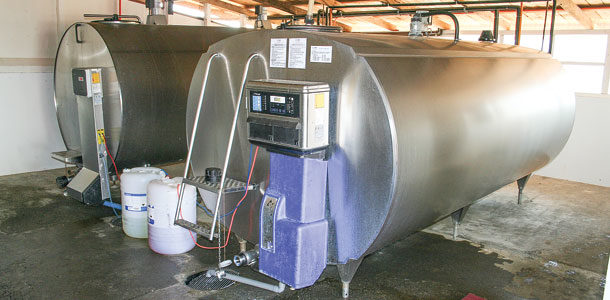In a survey five years in the making, the FDA found that more than 99 percent of bulk tank milk samples tested were free of drug residues of concern. The report was released March 5, 2015.
The FDA’s Center for Veterinary Medicine began the planning process in November 2010 to determine if dairy farms that had previous tissue residue violations from market cows sent to slaughter were also likely to have drug residues in raw milk.
Survey results
Samples were collected from farms that had tissue residue violations (targeted farms) and randomly selected farms (non-targeted farms).
A total of 1,918 samples were collected, and six were excluded from the results. In the targeted sample group of 953, there were 12 confirmed positive milk residues. One sample had two confirmed drug residues.
Four of the 959 non-targeted samples tested positive for residues. This amounts to 15 positive samples out of 1,912, meaning that 0.78 percent of the samples were confirmed with at least one drug residue.
The samples were tested for 31 different drug residues, more than is typically tested for in routine antibiotic residue milk samples performed on every load shipped to a processor.
None of the drugs found from the samples are FDA-approved for use in female dairy cattle 20 months old or older. The most commonly found drug was florfenicol, used to treat bovine respiratory disease (BRD) and foot rot.
“All these residues are avoidable by simply staying on-label with approved products for the appropriate class of animals,” says Dr. Gary Neubauer, senior manager, dairy technical services at Zoetis. “Using products that are not approved for the appropriate class of animals changes the tolerance levels to a no-tolerance level of zero.”
Neubauer is also the president of the National Mastitis Council and past chairman of the National Residue Avoidance Committee.
Media and consumer reaction
The release date of the results was delayed several times, giving National Milk Producers Federation (NMPF) and other dairy advocacy groups a chance to help shed a positive light on the report from the get-go.
NMPF Senior Vice President of Communications Chris Galen had anticipated the level of interest in the report from the media and reached out to an Associated Press writer in Washington who covers food policy. Galen gave the writer a heads-up about the report and provided NMPF’s official statement the morning the report was released.
The AP article came out that same day with a headline of “FDA study finds little evidence of antibiotics in milk.” It was soon picked up by several national media outlets, including Huffington Post, ABC and Fox News.
“There was really no other reporting that day by any other national media source, other than the AP story,” Galen says. “That really helped set the tone for subsequent coverage.”
However, there were media outlets that did take a negative approach and focused on the 1 percent of samples that tested positive for drug residues. NPR’s food blog site, “the salt” published a post written by Dan Charles with a headline of, “FDA tests turn up dairy farmers breaking the law on antibiotics.”
“The headline itself was overly alarmist,” Galen says. He contacted the reporter and challenged the tone of the piece. “There was nothing he wrote that was factually inaccurate, but I don’t think it was necessarily the whole truth in terms of context.”
The reporter responded to Galen but ultimately did not change or add to his blog post.
Overall, Galen believes that the coverage of these results has been positive.
“There are always going to be people who want to view the glass as half empty, although in this case it was 99-plus percent full, if you define ‘full’ as being 99 percent free of drug residues,” Galen says.
“We have to pat ourselves on the back with one hand, but on the other hand look for ways to continue improving on this track record and do things to get us closer to 100 percent. That includes re-examining the types of drugs used and the conditions under which drugs are used.”
Room for improvement
Of the drug residues found, almost none are currently required to be tested for as part of Grade A regulations. There is typically additional testing for sulfa drugs. Sulfamethazine, one of the six drugs found in the samples, is typically administered to beef and non-lactating dairy cattle to treat respiratory diseases and scours.
“Conceivably, [sulfamethazine] might have been caught by some additional testing that occurs now,” Galen says.
The other five drugs found are not currently screened in government-mandated regulations, but Galen says there may be private labs that test for those additional drugs.
But it is possible regulators may begin asking for additional drug screening. He anticipates the FDA results being thoroughly discussed at the National Conference on Interstate Milk Shipments at the end of April.
“We’re going to be carefully looking at those [FDA] proposals during NCIMS to see if they enhance the safety of the milk supply,” Galen says. “I think the FDA is going to say, ‘What else can be done beyond our current testing that might further embellish the health of the milk supply?’”
At the farm level, Galen believes the key to eliminating drug residues is for all involved to work together.
“We’ve already begun some discussions internally about what the next steps are,” he says. “I think the first one is that there’s always a need for more education. One of the messages we’ve used is, ‘An ounce of prevention is worth a pound of cure.’
In our case, an ounce of prevention is, ‘What educational materials and efforts can we create or double down on and further distribute to all stakeholders involved?’ It’s not just dairy farmers but also the veterinarians they work with, the pharmaceutical companies that produce the drugs, and state and federal regulators that oversee dairy production.”
The National Dairy FARM program offers an 80-page manual for reducing residues in both milk and meat. The manual is free to download.
Neubauer says the pharmaceutical companies are supportive of NMPF’s goals. He directs dairy producers and veterinarians seeking additional training and resources on residue risk avoidance to a website.
Among the many features of this site is the residue risk assessment, where producers can sit down with their veterinarians and complete a 10-point questionnaire. This assessment evaluates if records are being kept, if protocols are being followed and if products are being used properly.
Using the product on-label ensures:
- The product is used in the appropriate class of animal.
- The product is used for the indicated diseases.
- The proper dosage of the product is followed.
- The correct route of administration is used.
It’s also important to evaluate the use and need of over-the-counter products, Neubauer says.
“Following the label directions gives us the best guide of anything we can do,” he says. “If we do, we should not have any residues. I think we can get very close to that zero level, and that should be our goal.”
While both Galen and Neubauer acknowledge the work to be done in the industry, the results from the report serve as an accolade of the milk quality assurance efforts already implemented.
“We oftentimes talk the talk about the various steps taken to produce high-quality milk, but this is one of the most comprehensive analyses of milk safety [specific to drug residues] ever performed,” Galen says.
“Ninety-nine-plus percent of samples were negative for residues, so that is a very strong ‘yes’ answer to the question of, ‘Are we doing a good job of producing a high quality and safe product?’” PD
PHOTO
Chris Galen says, “We have to pat ourselves on the back with one hand, but on the other hand look for ways to continue improving on this track record and do things to get us closer to 100 percent.” Photo byPDstaff.

Emily Caldwell
Editor
Progressive Dairyman







